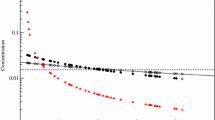Abstract
A sequence space model which describes the interplay of mutation and selection in molecular evolution is shown to be equivalent to an Ising quantum chain. Observable quantities tailored to match the biological situation are then employed to treat three fitness landscapes exactly.
Similar content being viewed by others
REFERENCES
M. Abramowitz and I. Stegun, Handbook of Mathematical Functions, 9th printing (Dover, New York, 1970).
E. Baake, Diploid models on sequence space, J. Biol. Syst. 3:343 (1995).
M. Baake, P. Chaselon, and M. Schlottmann, The Ising quantum chain with defects (II), Nucl. Phys. B 314:625 (1995).
N. H. Barton and M. Turelli, Natural and sexual selection on many loci, Genetics 127:229 (1991).
E. Baake, M. Baake, and H. Wagner, The Ising quantum chain is equivalent to a model of biological evolution, Phys. Rev. Lett. 78:559 (1997).
E. Baake, M. Baake, and H. Wagner, Quantum mechanics versus classical probability in biological evolution, Phys. Rev. E 57:1191 (1998).
N. H. Barton, The maintenance of polygenic variation through a balance between mutation and stabilizing selection, Genet. Res. Camb. 47:209 (1986).
E. Baake and T. Wiehe, Bifurcations in haploid and diploid sequence space models, J. Math. Biol. 35:321 (1997).
H. Bauer, Probability Theory (de Gruyter, Berlin, 1996).
O. Bratteli and D. W. Robinson, Operator Algebras and Quantum Statistical Mechanics, Vol. 1, 2nd edition (Springer, New York, 1987).
O. Bratteli and D.W. Robinson, Operator Algebras and Quantum Statistical Mechanics, Vol. 2, 2nd edition (Springer, New York, 1996).
R. Bürger, On the maintenance of genetic variation: Global analysis of Kimura's continuum-of-alleles model, J. Math. Biol. 24:34 (1986).
J. F. Crow and M. Kimura, An Introduction to Population Genetics Theory (Harper & Row, New York, 1970).
M. Eigen, J. S. McCaskill, and P. Schuster, The molecular quasi-species, Adv. Chem. Phys. 75:149 (1989).
W. J. Ewens, Mathematical Population Genetics (Springer, New York, 1979).
M. Fannes, H. Spohn, and A. Verbeure, Equilibrium states for mean field models, J. Math. Phys. 21:355 (1980).
H. Frahm, Integrable spin-\(\frac{1}{2}\) XXZ Heisenberg chain with competing interactions, J. Phys. A 25:1417 (1992).
S. Franz, L. Peliti, and M. Sellitto, An evolutionary version of the random energy model, J. Phys. A 26:L1195 (1993).
S. Galluccio, R. Graber, and Y.-C. Zhang, Diffusion on a hypercubic lattice with pinning potential: exact results for the error-catastrophe problem in biological evolution, J. Phys. A 29:L249 (1996).
T. Gerisch, Internal symmetries and limiting Gibbs states in quantum lattice mean field theories, Physica A 197:284 (1993).
T. Gerisch and A. Rieckers, The quantum statistical free energy minimum principle for multi-lattice mean field theories, Z. Naturforsch. 45a:931 (1990).
T. Gerisch, A. Rieckers, and H. J. Volkert, Thermodynamic formalism and phase transitions of generalized mean-field quantum lattice models, Z. Naturforsch. 53a:179 (1998).
J. Gillespie, The Causes of Molecular Evolution (Oxford University Press, New York, 1991).
S. Guiasu and A. Shenizer, The principle of maximum entropy, Math. Intelligencer 7:42 (1985).
E. R. Hansen, A Table of Series and Integrals (Prentice-Hall, Englewood-Cliffs, 1975).
J. Hofbauer, The selection mutation equation, J. Math. Biol. 23:41 (1985).
S. A. Kauffman, The Origin of Order (Oxford University Press, New York, 1993).
S. A. Kauffman and S. Johnson, Coevolution to the edge of chaos: coupled fitness landscapes, poised states, and coevolutionary avalanches, J. Theor. Biol. 149:467 (1991).
S. Lang, Algebra, 3rd edition (Addison-Wesley, Reading, Massachusetts, 1993).
I. Leuthäusser, An exact correspondence between Eigen's evolution model and a two-dimensional Ising system, J. Chem. Phys. 84:1884 (1984).
I. Leuthäusser, Physikalische und biologische Modelle der Selbstorganisation (Dissertation, Universität Braunschweig. 1987).
I. Leuthäusser, Statistical mechanics of Eigen's evolution model, J. Stat. Phys. 48:343 (1987).
E. H. Lieb, T. D. Schultz, and D. C. Mattis, Two soluble models of an antiferromagnetic chain, Ann. Phys. 16:407 (1961).
E. W. Montroll, R. B. Potts, and J. C. Ward, Correlations and spontaneous magnetization of the two-dimensional Ising-model, J. Math. Phys. 4:308 (1963).
P. Pfeuty, The one-dimensional Ising-model with a transverse field, Ann. Phys. 57:79 (1970).
R. B. Potts and J. C. Ward, The combinatorial method and the two-dimensional Ising-model, Progr. Theoret. Phys. 13:38 (1955).
M. Reed and B. Simon, Functional Analysis, Vol. 1, 2nd edition (Academic Press, San Diego, 1980).
G. R. Raggio and R. F. Werner, Quantum statistical mechanics of general mean field systems, Helvet. Phys. Acta 62:980 (1989).
D. S. Rumschitzky, Spectral properties of eigen evolution matrices, J. Math. Biol. 24:667 (1987).
T. D. Schultz, D. C. Mattis, and E. H. Lieb, Two-dimensional Ising model as a soluble problem of many fermions, Rev. Mod. Phys. 36:856 (1964).
E. Størmer, Large groups of automorphisms of C*-algebras, Commun. Math. Phys. 5:1 (1967).
E. Størmer, Symmetric states on infinite tensor products on C*-algebras, J. Funct. Anal. 3:48 (1969).
D. L. Swofford, G. J. Olsen, P. J. Waddell, and D. M. Hillis, Phylogenetic inference, in Molecular Systematics, D. M. Hillis, C. Moritz, and B. K. Mable, eds. (Sinauer, Sunderland, 1995).
P. Tarazona, Error threshold for molecular quasispecies as phase transition: From simple landscapes to spin glass models, Phys. Rev. A 45:6038 (1992).
C. J. Thompson, Mathematical Statistical Mechanics (Macmillan, New York, 1972).
C. J. Thompson and J. L. McBride, On Eigen's theory of the self-organization of matter and the evolution of biological macromolecules, Math. Biosci. 21:127 (1974).
W. Walter, Gewöhnliche Differentialgleichungen, 5th ed. (Springer, Berlin, 1993).
T. Wiehe, E. Baake, and P. Schuster, Error propagation in reproduction of diploid organisms, J. Theor. Biol. 177:1 (1995).
G. Woodcock and P. Higgs, Population evolution on a single-peaked landscape, J. Theor. Biol. 179:61 (1996).
C. N. Yang, The spontaneous magnetization of a two-dimensional Ising-model, Phys. Rev. 83:808 (1952).
Y.-C. Zhang, Quasispecies evolution of finite populations, Phys. Rev. A 55:R3187 (1997).
Author information
Authors and Affiliations
Rights and permissions
About this article
Cite this article
Wagner, H., Baake, E. & Gerisch, T. Ising Quantum Chain and Sequence Evolution. Journal of Statistical Physics 92, 1017–1052 (1998). https://doi.org/10.1023/A:1023048711599
Issue Date:
DOI: https://doi.org/10.1023/A:1023048711599




